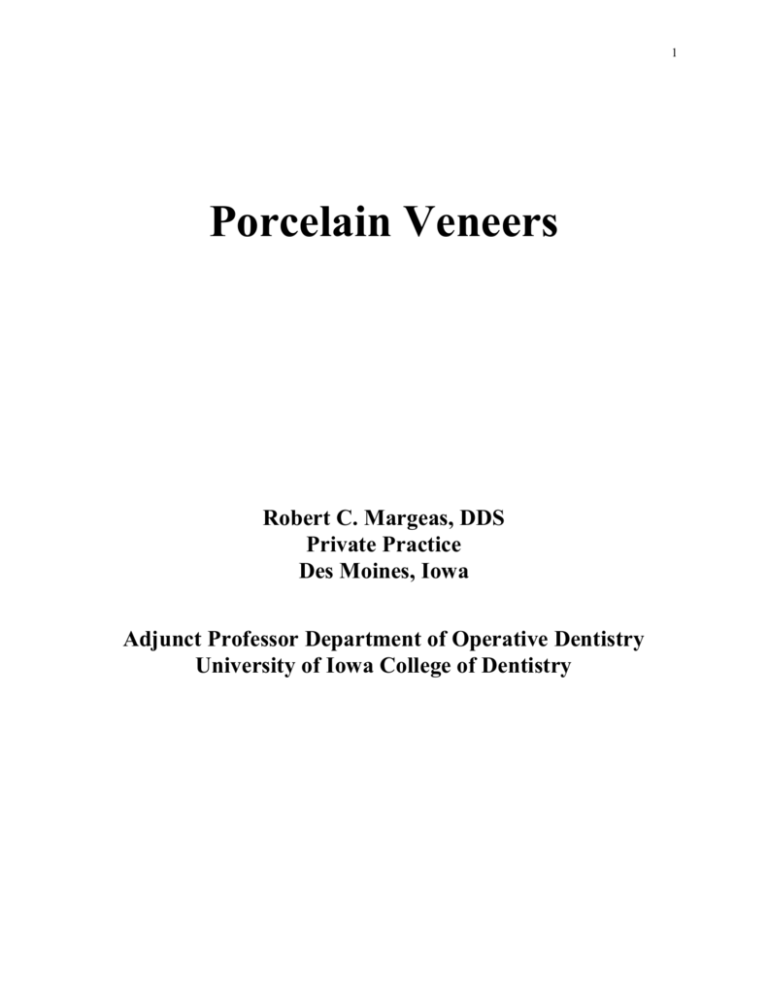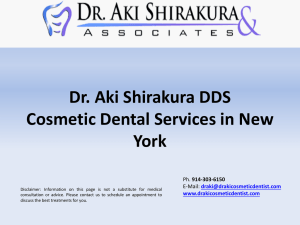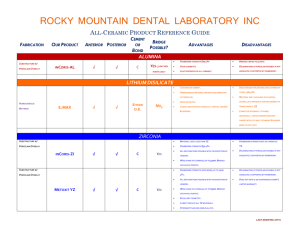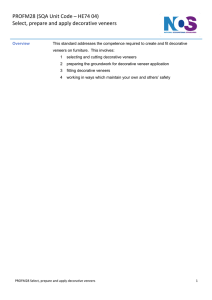Porcelain Veneer Technique
advertisement

1 Porcelain Veneers Robert C. Margeas, DDS Private Practice Des Moines, Iowa Adjunct Professor Department of Operative Dentistry University of Iowa College of Dentistry 2 Clinical Techniques for Porcelain Veneers Preliminary appointments 1. 2. 3. 4. 5. 6. 7. Perform thorough hard and soft tissue exam. Evaluate occlusion. Gingival tissue must be free of inflammation. Perform prophylaxis to remove calculus and external stain. Restore any caries, defective restorations, or exposed dentinal areas (if necessary). Make study models. Take digital photographs a. Intra-oral close-up (1.2 magnification) b. Commissure to commissure ("smile") c. Full-face d. Corresponding shade guide tab next to teeth Shade selection 1. 2. 3. 4. 5. Select existing shade before preparing teeth (at consultation or at beginning of preparation appointment). If done at consult, take a digital photograph of shade tab desired next to teeth. All bleaching should be completed before preparation of veneers One shade higher chroma may be selected for the canines and the cervical areas of incisors for a more natural appearance although when going light many patients like the teeth uniform light. Select opacity level after preparing the teeth. Preparation technique 1. Administer local anesthetic (sometimes not necessary). 2. Prepare depth grooves on facial: a. Depth: -- for mild to moderate color change: 0.3- 0.5 mm -- for profound color change: 0.75 mm -- for abraded or linguoverted teeth: (only as needed for proper porcelain thickness) 3 3. Gingival reduction: a. Prepare a light chamfer just above or at the gingival crest (this chamfer may be lowered to 0.5 mm below the gingival crest late with discolored teeth). b. Remember, enamel in this area is very thin. c. Depth of emergence profile preparation: -- for slight color change: 0.2 mm -- for moderate color change: 0.3 mm -- for profound color change: 0.4 mm d. Extend preparation onto proximal surfaces just labial to or slightly into contact areas. e. Prep must approach lingual-proximal line angles and may be slightly subgingival when closing diastemas. Normal Interproximal Preparations 4. Diastema Interproximal Preparations Prepare facial surface: a. Use same diamond that was used for gingival prep. b. Finished facial preparation should have 2 or 3 planes. 4 c. Blend facial, gingival, and lingual preps; eliminate sharp angles and undercuts (check proximal areas carefully). 5. Prepare incisal edge and lingual surface: a. Reduce incisal edge as needed to allow for 1.0-1.5 mm porcelain coverage. -- lingual margin should be a butt joint margin ending without chamfer on lingual surface -- check occlusion carefully; porcelain/enamel interfaces must not be in centric stop areas. -- round faco-incisal line angles 6. Finishing touches: a. Open incisal embrasures slightly b. Round any sharp angles. c. Use Gateway strips (Brasseler) to lighten contacts if necessary. Use an Spattern to avoid complete opening of contacts. Contact should be light enough to permit easy passage of a thin matrix strip. This helps to prevent gross tears in the impression and facilitates die separation. d. Polish facial surfaces of preparations as desired. Stay away from margins. Minor Color Change Major Color Change Impressions 1. 2. 3. Use retraction cord if desired. May not be necessary with minor shade change. Make a full-arch impression with a an accurate and stable polyvinylsiloxane or polyether impression material. Make a stable bite registration. 5 Temporization techniques 1. 2. 3. Minimal shade change veneers may not need temporization if the shape is unchanged. Individual direct composite resin veneers: a. "Spot-etch" enamel. b. Use unfilled resin only, not a 4th, 5th, 6th or 7th generation bonding agent. c. Apply and contour resin veneers using "free-hand" technique. Multi-unit composite resin veneers: (Not removed from teeth for polishing) a. Make a polyvinyl impression using a clear impression material such as RSVP (Cosmedent) in a clear non-retentive tray of your diagnostic model. b. Cover all gingival margins. Once set, remove from model and tray. c. Trim the lingual polyvinyl impression to just cover the lingual margins approximately 1mm. Trim the facial portion just incisal to the papilla d. Spot-etch each prepared tooth for added retention. This is not necessary if there is adequate mechanical retention. e. Place unfilled resin on the teeth and light cure. (Only unfilled resin, no dentin bonding agents.) f. Load matrix with appropriate shade of incisal RSVP composite material. g. Apply composite-filled matrix to prepared teeth. h Remove excess composite resin on facial and lingual with instruments. i. Light-cure the composite for 3 seconds on each tooth. h. Peel matrix from cured composite and trim excess prior to final cure. i. Light cure each tooth for 20 seconds. j. Freehand the gingival half and margins with RSVP cervical composite and light cure. k. Finish and polish as needed with finishing burs, discs, points, and cups without damaging preparation. A glaze, such as Temp Glaze or Biscover may be used. Laboratory communication 1. 2. 3. 4. 5. 6. 7. Take digital photograph of prepared teeth for veneers with shade guide of desired veneer shade next to teeth. Select an opacity level. Opaqueing should be in the veneer as much as possible. Tell laboratory the desired shade of the finished veneers. Also, describe the shade of prepared teeth and diagram any localized discolored areas. Whenever possible, have laboratory use translucent porcelain in the cervical area to provide a nice blend with the enamel (“contact lens effect”). Subopaqueing of preparations with composite may be necessary for tetracycline teeth. Send digital pre-op and post-preparation with shade tab photographs. Send model of provisionals for lab to replicate. Specify veneer length and location of finish line (e.g., wrap incisal). Describe desired surface anatomy -- smooth, moderate, heavy. 6 8. Although location of proximal finish line should be obvious, some labs want the dentist to tell whether these are labial, proximal, or lingual. (Lingual finish lines are indicated for diastema closures.) 9. If major contour changes are desired, send ideal waxed up model. 10. Keep instructions as simple as possible. Veneer try-in 1. 2. 3. 4. 5. 6. Place retraction cord if needed. Pumice the teeth. Use floss or sandpaper strips to clean interproximally. Avoid tissue trauma. Try in each veneer dry. Check the fit, marginal integrity, etc. Try in all veneers together with water or glycerin to check overall fit and appearance. Adjust contacts as needed with a fine diamond. Try in one or two veneers with try-in paste or resin cement: a. Water-soluble try-in pastes are easier to use than the actual cements. b. Check masking of discoloration and approximation of desired final appearance. (Resin shade will change slightly with curing.) c. Work quickly; light will set some of these resins rather rapidly. (Turn operatory light off during try-in and cementation.) d. The porcelain veneer should provide most of the color. Use of tints, opaquers, or resin combinations is risky business for most operators. e. Clean resin out of the veneers with acetone. Remove any excess resin from the teeth with cotton pellets, floss, etc. Clean each veneer by applying phosphoric acid for 10-15 seconds. Rinse thoroughly. Silanation Ideal Way a. Have the laboratory return the veneers unetched and unsilanated. They may be sand blasted with glass beads. b. Try veneers on the model for fit. c. Try veneers in the mouth with glycerine or try-in paste. d. Clean in ultra sonic with acetone. e. Etch inside of veneers with Hydrofluoric acid per manufacturers instructions. f. Apply 1-2 coats of a 2 part silane that was just mixed. g. Seat the veneers. Practical Way - A a. Have the laboratory sand blast and hydrofluoric acid etch the veneers. b. Have the laboratory silanate the veneers c. Try on model d. Try in mouth e. Clean in ultra sonic with acetone. f. Seat the veneers Practical Way - B a. Have the laboratory sand blast and hydrofluoric acid etch the veneers. b. The dentist should silanate the veneers. 7 c. d. e. f. Try on the model Try in the mouth Clean in ultra sonic with acetone Seat the veneers. Veneer cementation 1. 2. 3. 4. 5a. 5b. 6. 7. 8. 9. 10. 11. 12. 13. 14. Pumice the teeth again. Cement #8 and #9 together first. The placement technique is the same for other teeth, but it is critical to have #8 and 9 properly placed. Isolate #8 and 9 with Mylar strips plumbers tape or dead soft matrix on the distal surfaces. Etch enamel with 35-40% phosphoric acid gel. Rinse and dry thoroughly. Bonding to enamel only. Apply a dentin-enamel bonding agent or unfilled resin to the veneer and the tooth. Thin with a light stream of compressed air. Do not cure. Bonding to dentin and enamel. CAUTION: Some primers accelerate the setting of some resin cements. A fourth generation bonding agent is preferred(ie. All bond II or III, Scotch Bond MP, Opti Bond FL) Load the veneers with desired resin cement.. Gently, but firmly, press each to place. Do not allow veneer to lift off the tooth. If you use a light-body resin, tack down the veneer by curing a portion of the incisal edge with a very small diameter light tip (2 mm) for 5 seconds or less. Remove excess material around margins. a. Use an explorer for heavier resins, a sable brush or applicator tip for lighter ones to remove bulk of material. b. Clean off as much resin as possible prior to light curing. c. Avoid resin contact with adjacent preparations. Re-check position of veneers (even if they have been tacked down). Light-curing a. Use at least 60 seconds for each coverage area. b. Use the widest tips available, and two lights if available. c. Sequence: gingival one-third, then lingual/incisal, then facial. Check proximals for clear passage. a. Trim any excess with #12 scalpel blade. b. Avoid the use of abrasive strips at this point. If any resin contaminated adjacent teeth, scrape off the resin with a scalpel blade or similar instrument. Re-pumice those teeth if necessary. Try in next pair of veneers to assure fit. Finishing and polishing 1. 2. 3. Lingual surface a. Check occlusion. b. Adjust occlusion and finish lingual margins using football-shaped diamonds. Always use water spray when using diamonds to grind porcelain. Gingival margins a. Remove excess resin and adjust contour (emergence profile) as needed. b. Instruments: -- #12 scalpel blade -- Extra fine diamond Proximal surfaces a. If necessary, strip with Gateway Strips (Brasseler): 8 c. 4. Follow with Sof-Lex strips (3M), Flexi-strips(Cosmedent) or Epitex strips (GC America). Polishing a. Use 30-fluted carbide finishing burs, Ceramisté points, or Porcelain Polishers (Brasseler) to smooth any ground porcelain. Do not use severely pointed finishing burs, which can scar cementum. b. Use flexible discs (3M or Cosmedent) for accessible areas. c. Polish with porcelain polishing paste (Truluster -- Brasseler) on a rubber cup. Some operators follow with an aluminum oxide composite polishing paste also (e.g., Enamelize - Cosmedent). d. Work the paste interproximally with floss. e. Rinse following the use of each abrasive instrument. Recall 1. 2. 3. 4. 5. Recall the patient in one month or less to evaluate porcelain veneers. Check and adjust occlusion as necessary. Remove any excess resin cement that was not detected at cementation. Adjust contours of veneers if necessary. At subsequent recall appointments... a. Use curettes rather than scalers around veneers. b. Use composite polishing paste (Enamelize, Cosmedent) instead of conventional prophy paste. c. Use neutral NaF gel, not APF (which etches porcelain).





